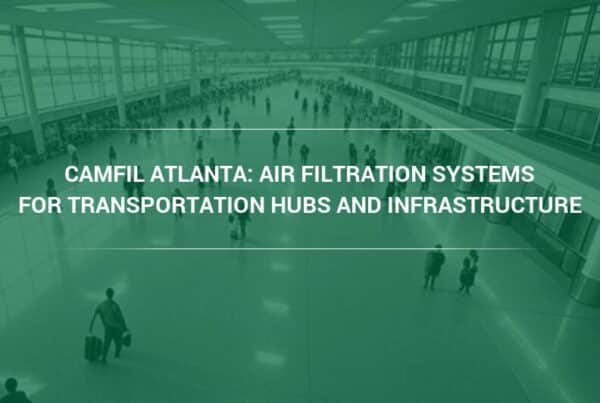The United Kingdom suffers from high levels of air pollution in its urban areas, with an estimated 40 million people living in air quality conditions considered illegal by regulations. In order to reduce pollution levels, the UK has created a “clean air zone” initiative. How do the UK’s clean air zones function? If they are effective, what are their implications?
What Is the True Need for the UK’s Clean Air Zones?
“According to a recent report commissioned by the UK’s Labor Party, approximately 40 million people throughout the UK live in areas where air pollution levels are illegal, harming their health and lifestyles,” says Kevin Wood, Vice President Sales & Marketing at Camfil USA . “The report suggests that around 59% of the UK’s total population lives in a town or city where nitrogen dioxide levels exceed the maximum of 40 mcg/m³ as established by safety regulations.” (1)
Pollution in the UK is made up of substances such as sulfur dioxide, nitrogen dioxide, and ammonia. In the atmosphere, these particles are measured as being either 2.5 µm or less, and larger than 10 µm, known as PM 2.5 and PM 10 respectively. PM 2.5 particulate matter is considered to be a vastly dangerous to people’s health, as the particles are small enough to penetrate into a person’s lungs and nervous system, doing continual damage to their health.
Around the world, air pollution is thought to be responsible for approximately seven million premature deaths every year. Air pollution can cause heart conditions and stroke, respiratory diseases like asthma, and lung cancer. In the UK alone, around 30,000 people every year die prematurely from conditions associated with exposure to air pollutants.
How Do the UK’s Clean Air Zones Work?
In order to combat the UK’s air pollution problem, the UK government has proposed a series of initiatives which include “clean air zones,” where local authorities will be expected to create and implement pollution reducing plans. As for how the UK’s clean air zones work, potential plans might include encouraging public transportation to switch to ultra-low emission vehicles, levying fines on certain types of motor vehicles within the zone, and retrofitting polluting technologies with improvements to reduce their emissions.
“An air quality consultation paper released by the UK government describes pollution from diesel vehicles as the main source of the UK’s air pollution problem,” says Wood. “Therefore, much of the methods suggested by the paper revolve around how to reduce the use of diesel vehicles.” (2)
Plans for reducing pollution from diesel vehicles and other sources rely heavily on encouraging the private adoption of ultra-low emission vehicles and installing adequate charging spots for electric vehicles. The report also suggests encouraging citizens to make use of public transportation, walking, cycling, and ridesharing.
“These ultra-low emission zones ultimately attempt to both improve air quality and give the associated health benefits to citizens of the United Kingdom in a way that is supportive of economic growth,” states Wood. “London’s Mayor, Sadiq Khan, has already moved towards expanding current charges on the most polluting vehicles to heavy diesel use vehicles. This is an attempt to discourage the operation of pollution-heavy vehicles in London and encourage the use of cleaner vehicles.” (3)
Looking Beyond the UK’s Clean Air Zones
Looking beyond the UK’s clean air zones to the future of pollution in the UK, it is unknown how effective the clean air zone initiative will be in reducing pollution. Critics of the plan argue it is weak, and simply putting the responsibility on the shoulders of local authorities to deal with what should be a national issue.
“Critics of the clean air zone plan argue that the government has not committed to a plan for scrapping diesel vehicles, which can be crucial in persuading drivers to adopt lower emission vehicles. Furthermore, there should be a national network of clean air zones overseen by the national government, instead of having local authorities deal with the issue of illegally polluted streets and high emission vehicles,” explains Wood. “Critics note that the report contains few substantive proposals and that it does not cite any specific towns or cities where charges would be possible for polluting vehicles.” (4)
While the implementation of the plan as it currently exists may leave much to be desired, the suggested solutions to the air pollution problem are sound. Increased adoption of low emission vehicles, pollution fines, greater access to public transportation, and pollution limiting technology are proven ways to combat air pollution. If the clean air zone initiative proves successful at reducing pollution in cities like London, it could be used as a model for cities that struggle with pollution around the globe.
The UK’s clean air zones could help other cities around the world combat their air pollution with an effective system, but only if the logistical problems of implementing the system and ensuring its efficacy are dealt with first.
How to Learn More about the UK’s Clean Air Zones
If you would like to learn more about the hazards of air pollution that the UK’s clean air zones are trying to target, contact Camfil now. Camfil can educate you in the hazards of air pollution and provide you with high-quality filters to ensure your health and safety.
Lynne Laake
Camfil USA Air Filters
T: 888.599.6620,
E: Lynne.Laake@camfil.com
F: Friend Camfil USA on Facebook
T: Follow Camfil USA on Twitter
Y: Watch Camfil Videos on YouTube
SOURCES
http://www.theactuary.com/news/2017/05/clean-air-zones-proposed-to-tackle-illegal-pollution-levels/
https://www.london.gov.uk/press-releases/mayoral/mayor-plans-to-introduce-ulez-in-april-2019



